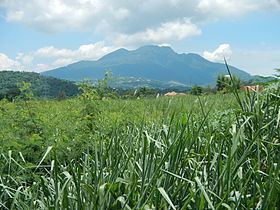Volcanic arc/belt Macoloc Corridor Elevation 1,090 m | Last eruption 1350 ± 100 years | |
 | ||
Similar Laguna Caldera, Malepunyo Mountain Range, Mount Sembrano, Mount Mayabobo, Mount Banahaw | ||
The Laguna Volcanic Field, also known as the San Pablo Volcanic Field, is a volcanic field in the Philippines, located between Laguna de Bay, Mount Banahaw volcano complex and Mount Malepunyo range. It is part of the larger Southwestern Luzon Volcanic Field (SWLVF). From Manila, it is about 50 kilometres (31 mi) southeast to Mount Makiling, its most prominent volcanic feature.
Contents
Map of Laguna Volcanic Field, Calauan, Laguna, Philippines
The field is composed of over 200 dormant and monogenetic maars, crater lakes, scoria cones, and stratovolcanoes, the tallest of which is Mount Makiling at 1,090 m (3,580 ft) in elevation. Many of the maars are aligned along a NE-SW trend. Three generations of maars are present, with the oldest being sediment-filled, like the ones found in Calauan. The youngest maars contain deep lakes with many concentrated in the city of San Pablo. The youngest maar, 1.2-kilometre (0.75 mi) wide Sampaloc Lake was formed about 500–700 years ago according to local legend, the last major activity in the volcanic field.
Volcanism is still evident through the presence of geothermal areas like mud and hot springs. The areas south of Mt. Makiling is the site of one of the earliest geothermal plants in the country.
Volcanic features
The Philippine Institute of Volcanology and Seismology (PHIVOLCS) lists some of the maars and cones situated in the Laguna volcanic field. All are classified as inactive.
